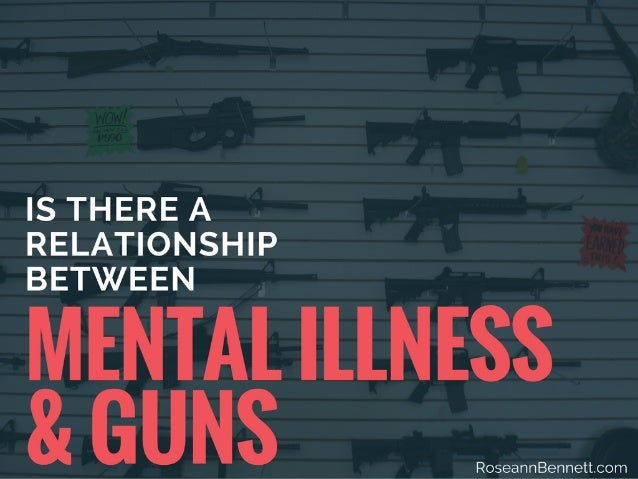Understanding The Complex Relationship Between Mental Illness And Violence: An Academic Perspective

Table of Contents
Dispelling Myths: Mental Illness Does Not Equal Violence
The Statistical Reality:
The overwhelming majority of individuals with mental illnesses are not violent. The association between mental illness and violence is significantly weaker than commonly perceived. Attributing violence solely to mental illness is a dangerous fallacy that fuels stigma and hinders effective intervention.
- Studies consistently show that the prevalence of violence among individuals with mental illnesses is only slightly higher than in the general population. For example, research indicates that individuals with schizophrenia may have a slightly elevated risk of violence, but this risk is often significantly influenced by other factors. It's crucial to avoid generalizations and understand the complexity of each case.
- Media portrayals often exacerbate this misconception. Sensationalized news stories and fictional narratives frequently depict individuals with mental illnesses as inherently aggressive, creating a distorted image in the public's mind and fueling harmful stereotypes. This misrepresentation hinders efforts to destigmatize mental illness and seek help.
The Importance of Context:
Violence is a multifaceted issue stemming from a complex interplay of factors, with mental illness being only one potential piece of the puzzle. Substance abuse, socioeconomic factors, childhood trauma, and lack of social support play crucial roles.
- Contributing factors such as unemployment, poverty, lack of access to healthcare, and exposure to violence significantly increase the risk of violent behavior, regardless of mental health status. Substance abuse, especially when combined with untreated mental illness, can act as a potent catalyst for violence.
- For example, an individual experiencing an untreated psychotic episode might be more likely to engage in violence if they are also experiencing homelessness, substance withdrawal, and social isolation. These interacting factors create a high-risk environment, making it crucial to address the entire picture rather than focusing solely on the mental illness diagnosis.
Specific Mental Illnesses and Their Association with Violence (if any)
Schizophrenia and Violence:
Research suggests a slightly elevated risk of violence in individuals with schizophrenia compared to the general population. However, this increased risk is often associated with specific factors, such as untreated psychosis, substance abuse, and negative symptoms.
- Symptoms like paranoia and delusions can, in rare cases, contribute to violent behavior if left unmanaged. However, early intervention and appropriate treatment, including medication and psychosocial support, significantly reduce this risk.
- Effective treatment is paramount. Medication can help manage psychotic symptoms, while therapy can address underlying issues and improve coping mechanisms. This proactive approach reduces the likelihood of violent behavior significantly.
Bipolar Disorder and Violence:
Similarly, individuals with bipolar disorder may exhibit increased irritability and impulsivity during manic episodes. However, this is not inherent to the illness itself but a consequence of the untreated condition.
- Untreated mania can lead to impulsive and reckless behavior, potentially resulting in violence. However, mood stabilizers and other treatments are highly effective in managing these symptoms and preventing such episodes.
- Early identification and prompt treatment are crucial. With proper medication and therapy, individuals with bipolar disorder can lead fulfilling lives without resorting to violence.
Other Mental Illnesses and Violence:
While some studies suggest weak associations between other conditions like borderline personality disorder and antisocial personality disorder and violence, it's essential to remember these are broad generalizations. Comorbidities and individual circumstances drastically influence the risk.
- Conditions like borderline personality disorder and antisocial personality disorder are often associated with impulsivity and emotional dysregulation, which can, in some cases, contribute to violent behavior. However, this is not always the case, and individual circumstances must be carefully considered.
- Focusing solely on diagnostic labels without considering the individual's life experiences, social environment, and access to resources risks perpetuating harmful stereotypes and hindering effective intervention.
The Role of Effective Treatment and Support in Violence Prevention
Access to Mental Healthcare:
Access to affordable and comprehensive mental healthcare is paramount in preventing violence. Early intervention and ongoing treatment are crucial in managing symptoms and reducing the risk of violence.
- Early intervention can prevent escalation and the development of severe symptoms. Access to timely diagnosis, medication, and therapy can help stabilize individuals, improving their overall well-being and decreasing the likelihood of violence.
- Effective treatment significantly reduces the risk of violent behavior. Managing symptoms, improving coping skills, and addressing underlying issues contribute to better mental health and reduce the chances of violent incidents.
Community Support and Resources:
Community-based support systems and resources play a critical role in reducing violence risk. Peer support groups, family therapy, and strong social support networks can offer individuals a sense of belonging and help in managing their mental health.
- Peer support groups provide a safe space for individuals to share experiences and learn coping strategies from others who understand their challenges. Family therapy can improve communication and strengthen family bonds, offering crucial support for individuals struggling with mental illness.
- Reducing stigma and promoting mental health literacy within communities is crucial. Educating the public about mental illness, dispelling myths, and fostering empathy can create a more supportive environment for those struggling with mental health challenges.
Conclusion:
The relationship between mental illness and violence is far more complex and nuanced than often portrayed. Dispelling the myth that mental illness inherently equates to violence is crucial. The majority of individuals with mental illnesses are not violent, and violence is typically the result of a complex interplay of factors, only one of which may be mental illness. Effective treatment, access to affordable mental healthcare, and strong community support are paramount in preventing violence. We must advocate for improved mental healthcare access and promote a more informed and compassionate understanding of mental illness to effectively address both mental health challenges and violence prevention. For further information on understanding the link between mental illness and violence, and for resources dedicated to mental health and violence prevention, please visit the websites of [insert relevant organizations and resources here].

Featured Posts
-
 150 Million Awaits Credit Suisse Whistleblowers
May 10, 2025
150 Million Awaits Credit Suisse Whistleblowers
May 10, 2025 -
 Analysis Dangote Refinery And Its Effect On Nnpc Fuel Prices Thisdaylive
May 10, 2025
Analysis Dangote Refinery And Its Effect On Nnpc Fuel Prices Thisdaylive
May 10, 2025 -
 Inquiry Into Nottingham Attacks Appointment Of Judge Deborah Taylor
May 10, 2025
Inquiry Into Nottingham Attacks Appointment Of Judge Deborah Taylor
May 10, 2025 -
 Wynne Evans Illness Update Recovery Progress And Future Performances
May 10, 2025
Wynne Evans Illness Update Recovery Progress And Future Performances
May 10, 2025 -
 The Real Safe Bet Investing Strategies For Secure Returns
May 10, 2025
The Real Safe Bet Investing Strategies For Secure Returns
May 10, 2025
